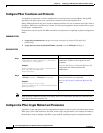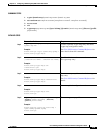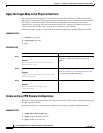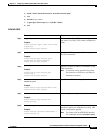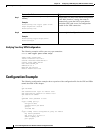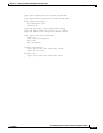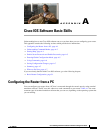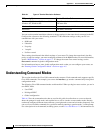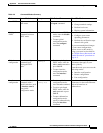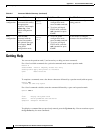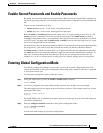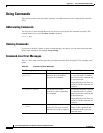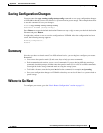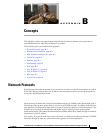
A-2
Cisco 819 Integrated Services Routers Software Configuration Guide
OL-18906-02
Appendix A Cisco IOS Software Basic Skills
Understanding Command Modes
You can use the terminal emulation software to change settings for the router that is connected to the PC.
Configure the software to the following standard VT-100 emulation settings so that your PC can
communicate with your router:
• 9600 baud
• 8 data bits
• No parity
• 1 stop bit
• No flow control
These settings should match the default settings of your router. To change the router baud, data bits,
parity, or stop bits settings, you must reconfigure parameters in the ROM monitor. For more information,
see the
“ROM Monitor” section on page C-1. To change the router flow control setting, use the
flowcontrol command in global configuration mode.
For information on how to enter global configuration mode so that you can configure your router, see
the
“Entering Global Configuration Mode” section on page A-5.
Understanding Command Modes
This section describes the Cisco IOS command mode structure. Each command mode supports specific
Cisco IOS commands. For example, you can use the interface type number command only from global
configuration mode.
The following Cisco IOS command modes are hierarchical. When you begin a router session, you are in
user EXEC mode.
• User EXEC
• Privileged EXEC
• Global configuration
Table A-2 lists the command modes that are used in this guide, describes how to access each mode,
shows the prompt for each mode, and explains how to exit to a mode or enter another mode. Because
each mode configures different router elements, you might need to enter and exit modes frequently. You
can see a list of available commands for a particular mode by entering a question mark (?) at the prompt.
For a description of each command, including syntax, see the
Cisco IOS Release 12.3 documentation set.
Ta b l e A-1 Types of Terminal Emulation Software
PC Operating System Terminal Emulation Software
Windows 95, Windows 98, Windows 2000,
Windows
NT, Windows XP
HyperTerm (included with Windows software),
ProComm Plus
Windows 3.1 Terminal (included with Windows software)
Macintosh ProComm, VersaTerm



